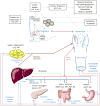Recent advances in clinical practice challenges and opportunities in the management of obesity
- PMID: 24402654
- PMCID: PMC4170188
- DOI: 10.1136/gutjnl-2013-306235
Recent advances in clinical practice challenges and opportunities in the management of obesity
Abstract
Despite advances in understanding the roles of adiposity, food intake, GI and adipocyte-related hormones, inflammatory mediators, the gut-brain axis and the hypothalamic nervous system in the pathophysiology of obesity, the effects of different therapeutic interventions on those pathophysiological mechanisms are controversial. There are still no low-cost, safe, effective treatments for obesity and its complications. Currently, bariatric surgical approaches targeting the GI tract are more effective than non-surgical approaches in inducing weight reduction and resolving obesity-related comorbidities. However, current guidelines emphasise non-surgical approaches through lifestyle modification and medications to achieve slow weight loss, which is not usually sustained and may be associated with medication-related side effects. This review analyses current central, peripheral or hormonal targets to treat obesity and addresses challenges and opportunities to develop novel approaches for obesity.
Keywords: BRAIN/GUT INTERACTION; GASTROINTESTINAL HORMONES; OBESITY.
Conflict of interest statement
Figures



References
-
- Anderson JW, Konz EC, Frederich RC, Wood CL. Long-term weight-loss maintenance: a meta-analysis of US studies. The American journal of clinical nutrition. 2001;74:579–84. - PubMed
-
- Sjöström L. Review of the key results from the Swedish Obese Subjects (SOS) trial - a prospective controlled intervention study of bariatric surgery. Journal of internal medicine. 2013;273:219–34. - PubMed
-
- Pi-Sunyer FX, Becker DM, Bouchard C, Carleton RA, Colditz GA, Dietz WH, et al. Clinical guidelines on the identification, evaluation, and treatment of overweight and obesity in adults: Executive summary. American Journal of Clinical Nutrition. 1998;68:899–917. - PubMed
Publication types
MeSH terms
Substances
Grants and funding
LinkOut - more resources
Full Text Sources
Other Literature Sources
Medical
